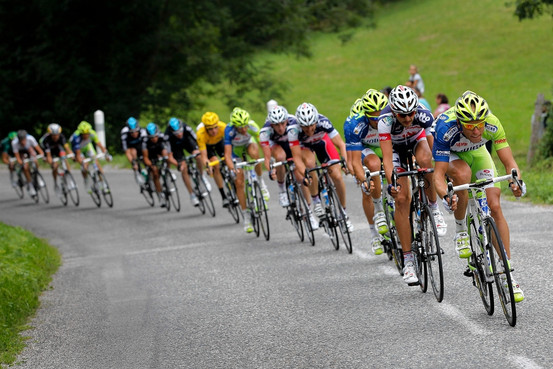Strength Training to Ramp up Your Cycling Game

Did you know that May is National Cycling Month? Well, now you do! Driven has worked with many cyclists of many levels over the years and we are often asked why weight training is always included in our programming for primarily endurance athletes. This article seeks to clarify some of the “programming wizardry” we get into around here!
Bone density
A popular topic brought up when training women, bone density concerns arise in both male and female cycling athletes. A study by Stewart and Hannan observed a decrease in spinal bone density in male cycling athletes, while a similar study on women revealed decreased bone mineral content in their lumbar spines after a year of cycling training as well (Sherk et.al.). On the other end of this spectrum, Westcott concluded in 2012 that resistance training has been found to increase bone mineral content by 1-3% after just ten weeks of training. This is not the only study to conclude that resistance training builds stronger bones, and the literature has consistently come to that conclusion each time it is tested. Therefore, when it comes to bone loss prevention and bone strength, adding weight training to the program gives cyclists an advantage over their competition who neglects this area of training.
Injury Prevention
Resistance training, when performed properly, inherently causes exercisers to use their core muscles more for stabilization of the body. Hearing things like “pull your belly button to your spine” and “engage the core” is common on weight lifting days with any good trainer. By targeting these deep muscles through adding load to the body, we are training them to know how to brace you and support you better even when that load is not there. Stronger, more active core muscles mean it is easier to maintain good spinal posture. In a sport like cycling, where leaning forward is a major component, spinal posture is easy to lose. Learning to activate the core muscles during your training off the bike will help you to maintain good posture in everyday life and prevent injury to the spine (Willson et.al., 2005).
Work efficiency
This term basically means that you can perform more work using less energy. So when you go all-out, it’s at a greater work load than before. A greater work load means time and strength improvements. In the 2010 study released by Arnstein et.al., two groups of cyclists were put through an 8-week training program that was either biking-only or biking plus strength days. At the end of the intervention, the strength group had improved their time to exhaustion and maximal aerobic power significantly more than the biking-only group. By incorporating strength into a cycling training routine, power output can increase and allow athletes to perform at a higher workload through their race. Translation? You can push harder for longer and potentially decrease your race time.
Performance
Paton and Hopkins conducted a study in 2005 which proved that explosive, high-resistance training improves overall cycling performance. The same exercise efficiency developed from a resistance program causes “major gains in sprint and endurance performance.” In the Arnstein study, strength training was also shown to increase maximal power, which has implications for improvement of the final sprint at the end of the race. Between these two publications, strength training has clear implications for the improvement of overall race pace and the final push-through to finish a ride strong.
Final thoughts
There are tons of studies we can go through about the benefits of strength training, but the ones listed above seem extra-relevant for cyclists. While performance may be your primary goal right now, health needs to be protected as well and any training program that allows for both will be superior to anything else you can do. Well-performed strength training has been shown to improve both health and performance in cyclists. By incorporating it into your accessory training to improve as a cyclist, performance gains can be made and your goals exceeded.
Sources:
-Arnstein, S., Søren, Ø. Bjerkaas, M., Larsen, M.H., Hoff, J., Helgerud, J. (2010, August).
-Maximal strength training improves cycling economy in competitive cyclists. Journal of Strength & Conditioning Research. Doi: 10.1519/JSC.0b013e3181aeb16a
-Paton, C., Hopkins, W.G. (2005, November). Combining explosive and high-resistance training improves performance in competitive cyclists. Journal of Strength & Conditioning Research. Retrieved from: http://journals.lww.com/nsca-jscr/abstract/2005/11000/combining_explosive_and_high_resistance_training.17.aspx
-Sherk, V.D., Barry, D.W., Villalon, K.L., Hanse, K.C., Wolfe, P., Kohrt, W.M. (2015, July 1).
-Bone loss over one year of training and competition in female cyclists. Clinical Journal of Sports Medicine. doi: 10.1097/JSM.0000000000000050
-Stewart, A.D., Hannan, J. (2000, August). Total and regional bone density in male runners, cyclists, and controls. Medicine and Science in Sports Exercise. doi: 10.1097/00005768-200008000-00003
-Westcott, W. (2012, July). Resistance training is medicine: effects of strength training on health. Current Sports Medicine Reports. doi: 10.1249/JSR.0b013e31825dabb8
-Willson, J.D., Dougherty, C.P., Ireland, M.L., Davis, I.M. (2005, September). Core stability and its relationship to lower extremity function and injury. Journal of the American Academy of Orthopedic Surgeons.
-n.a. (2017). Timekeeping and more cycling events. MYLAPS Sports Timing. Retrieved from: https://www.mylaps.com/sports/active-sports/cycling/
SHARE IT

